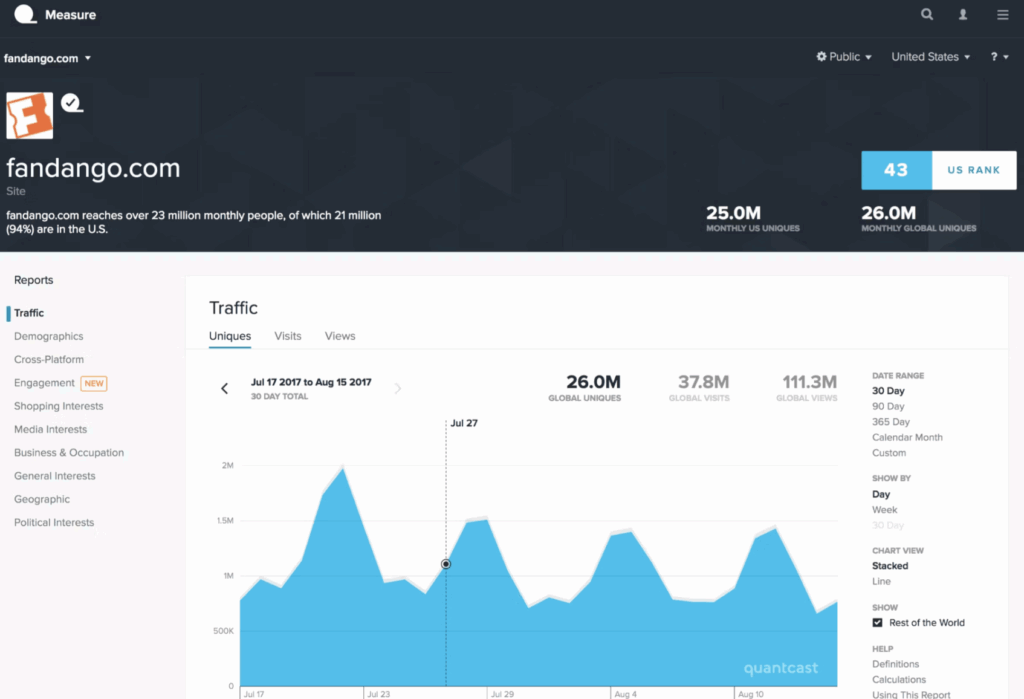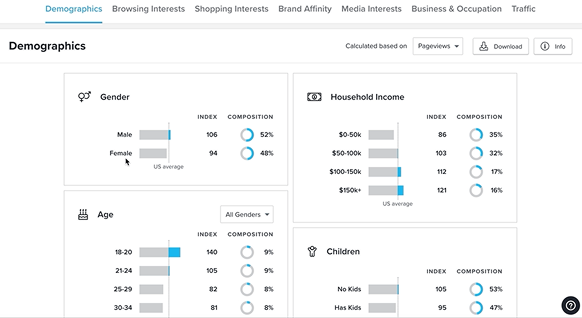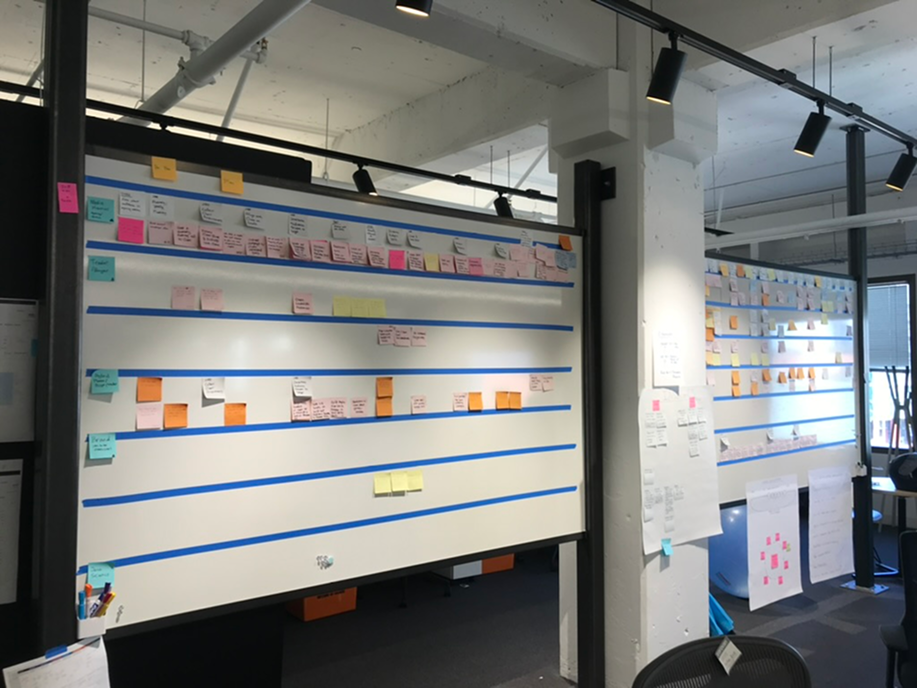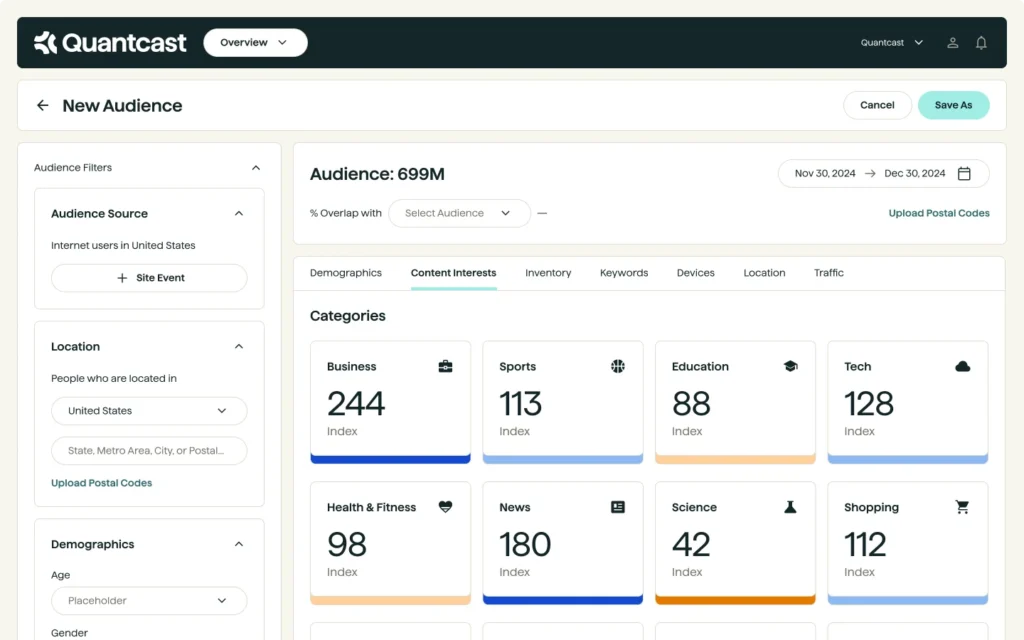In order to finally launch a workflow-revolutionizing ad platform, an entire company’s approach to vision, validation and product development had to be rewired. I helped design lead that charge.
Scope
Full strategic and UX redesign of Quantcast’s ad platform for marketers, launching a self-serve experience built on AI and deep audience insights
Role & Team
Role: Principal Product Designer
Team: Cross-functional with PMs, engineers, data scientists, legal, sales, and support
Impact
Platform launched in 2021 with strong adoption, a 44% increase in conversions, and a 50% reduction in campaign setup time compared to other DSPs. (Forrester TEI).
Finding Signal in Noise
With the help of machine learning and AI, Quantcast had been at the forefront of audience analytics for over a decade. Its flagship product, Quantcast Measure, gave publishers deep, real-time access to their audiences. Its online ad targeting services were used by many of the world’s largest brands. But when it came time to build a self-serve platform for marketers, the challenge was fundamentally different.
The Problem
Founded in 2006, Quantcast had perfected the art of high-performing, AI-informed online ad campaigns for the world’s top brands. But in order to scale beyond its managed service model and compete with the likes of Google and Facebook, it needed to create a self-serve campaign platform.uantcast had tried before to enter the self-serve ad space—and failed. I joined during a “come to Jesus” moment: a collective realization that building a successful platform would require not just strong data science, but a full cultural and organizational shift toward user-centered, hypothesis-driven product development.
The existing tools were fragmented, siloed, and built on assumptions that hadn’t been tested with real users. There were no marketer personas, no journey maps, and no validated product strategy.
Previous attempts had stalled due to:
- Competing internal visions and tool sprawl
- Lack of alignment between product, engineering, and GTM
- A waterfall approach that left little room for real-time feedback
- Silos that prevented user research findings from being widely known, understood or adopted
My role was not just to design screens, but to help design the organization’s new approach to product development.
My Role
As Principal Product Designer, I:
- Led the strategic redesign of the platform alongside PMs and data science, with a strong focus on validated user tasks
- Introduced lean and iterative design methodologies
- Recruited and ran org-wide research programs that deeply involved every member of the team
- Facilitated workshops to align stakeholders across silos
- Instituted user interviews and validation steps into every project, ensuring clarity on JTBD and product goals
- Coached and mentored designers, PMs and other team members on user research best practices to increase team velocity
- Brought both users and non-users into the office for the first time to do usability testing sessions that the entire scrum team watched live
- Designed and evolved campaign flows and UX patterns for self-serve advertising
Approach
1. Starting from Signal: Research, Mapping, and Reframing
We began with what we had: a successful publisher tool and deep AI-driven audience insights. As one of my first projects at Quantcast, I had led the redesign of the audience insights tool, Measure, with a focus on user pain points and solution validation; this had resulted in massive gains in adoption and loyalty metrics, which helped me gain the trust of the organization to continue using this more user-centered approach.

Prior versions of Measure hid primary actions for core workflows under many layers of small and obscure links; many users weren’t aware of the product’s full capabilities and spent hours of time navigating cumbersome flows.

I interviewed dozens of publishers to identify and validate core user tasks, journeys and workflows. Based on these hypotheses, I tested prototypes with them and created a validated redesign that increased engagement by over 40%.
I worked cross-functionally to:
-
- Audit publisher workflows and evaluate overlap with marketer use cases
-
- Interview sales, customer support, and existing clients
-
- Facilitate workshops to map out assumptions, tasks, and pain points across the marketing journey
-
- Recruit and run generative research with new marketers to fill in the blanks

To get an idea of how much our organization knew about the customer’s journey, identify gaps and create a roadmap for user research, I created a huge multi-persona customer journey map and asked PMs, sales reps, account managers, customer service and engineers to contribute the user tasks they were aware of for the use cases we cared about.
2. Building the Infrastructure for Lean, User-Centered Work
While we’d gone through periods with researchers and pilot programs that experimented with dual-track customer discovery, there was widespread fragmentation and inconsistency in the ways that different teams approached user problems and use cases. We’d begun dipping our toes into jobs to be done and other user-centered approaches, but when it came to working on actual ideas, customer use cases often got lost in the shuffle. With the conviction that I and other designers were the crucial link between customers and product, I:
-
- Wrote research plans, trained PMs and engineers to run sessions
-
- Worked with project managers to establish ongoing beta user cohorts who met with us weekly
-
- Introduced hypothesis-based design cycles: define use case → prototype → test → refine
-
- Pushed leadership to include designers on visits to client offices to collect insights on their workflows
-
- Ran internal usability studies, recorded live sessions, and made findings visible across the org
-
- Mentored junior designers on how to present data-driven hypotheses and push for seats at the visioning table

For the first time in the company’s history, I recruited non-users with our persona profile and brought them into the office for live usability tests of proposed flows that everyone on our team watched from a remote viewing room. Findings from the study were displayed prominently in high-traffic areas of the office. Some of the friction points revealed in these sessions resulted in a major pivot in what we were about to build.
3. Designing a Platform, Not a Patchwork
From the beginning, we knew the vision was bigger than a new UI. We were designing a new nervous system:
-
- Unified campaign planning, activation, and measurement into one seamless flow
-
- Used AI to surface actionable insights without overwhelming the user
-
- Prioritized transparency, speed, and joy in an industry plagued by opacity and complexity
Outcomes
-
- Launched the new Quantcast Platform in 2021 after multiple successful betas
-
- Consistently beat internal milestones and revenue forecasts
-
- Forrester TEI study reported a:
-
- 44% increase in customer conversions
-
- 50% reduction in time spent on campaign planning and reporting
-
- Forrester TEI study reported a:
-
- Used by major brands like Yokohama, Yourtown, and GroupM

What Made It Work
-
- A shift from waterfall to iterative design, seeded and driven by the design team
-
- Embedded research and feedback loops across the product lifecycle
-
- Strategic use of design as a tool for org alignment and product vision
Reflections
What started as a redesign and a new product became a reorientation of an entire company toward product truth. What started as a blank slate became a learning machine. We didn’t just ship features: we designed clarity into a deeply complex system.
“Design became the organizing logic for a product that had lost its shape.”
Want more case studies?